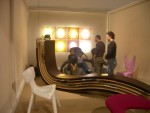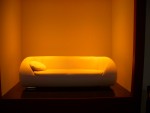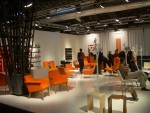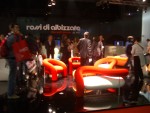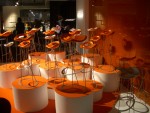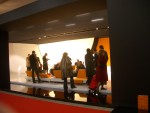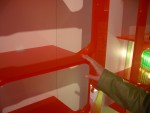December 18, 2004
New Solar Cells
[...] a light, flexible solar panel that is a little thicker than photographic film and can easily be applied to everyday fabrics. The thin, bendy solar panels, which could be on the market within three years, are the fruit of a three-nation European Union research project called H-Alpha Solar (H-AS).
(from an article in New Scientist)
In the article they're talking about using these in large patches to recharge cell phones and iPods while you're walking around. I think they'll actually be much more useful as ways to create small computational objects that live outside and are always on. Depending on durability, cost, power, and recyclability imagine integrating these into, say, stuff that's destined to lie by the side of the road. McDonald's cups with a solar patch, a small amount of hardware and a tiny transmitter could create an ad hoc trash network from coast to coast.
Or something.
On that note, I wonder if there's a battery that can be made of leachate. That way, maybe technology could have a built-in leachate mode that used the power of the garbage dump to power little computational devices--each dump could form its own computer, making money off of the trash.
November 01, 2004
Inkjet printed circuit boards
Seiko Epson Corporation today announced that it has succeeded in leveraging its proprietary inkjet technology to develop ultra-thin 20-layer circuit board.
(from this article)
Nifty! I've read of inkjets being used for all kinds of stuff and this seems like a particularly clever use. Here's an article on printing injet antennas with conductive ink. The injet antenna piece also has a nice story about how innovation happens by accident:
Carclo was working on a way to customize cell phones by printing personal images on the plastic bodies, when it ran into a problem trying to print Motorola’s silver metallic logo.[...]
Carclo developed a prototype printer that's about the size of a small photocopier. It can print copper antennas on polycarbonate, polyester, polyethylene and other plastic films used for RFID tags, as well as on paper and cardboard. The copper layer can be as thin as half a micron and is almost as conductive as a solid copper antenna. And unlike bulk metal antennas, the printed antenna is recyclable.
I wonder if any of the check printing magnetic inks have enough conductivity to be usable for home-grown circuit printing...
Between these two technologies and the various other printer-based technologies (such as the polyester rapid prototyping rigs that are another kind of inkjet printer), I wonder how long before whole electronic devices can be printed on demand?
October 28, 2004
Form Factors
It'll be interesting to see how new technology integrates with people's existing home environments. Here's a nice description of how matching people's expectations with the new demands of consumer equipment, from this article:
The bulky armoires people already have in their homes hide the flat panels' sleekness, the main motivation for investing thousands of dollars in them. As more people are buying these televisions, new options are being designed, including compact consoles.
This is an interesting replay of the tension that happened when radio equipment became small enough that it was not longer necessary to have a big bulky piece of furniture and the popularity of tabletop models took off. People's attitudes of what constitututed an appropriate relationship between the furniture in their homes and the technology shifted in response to both the shifting technology constraints and their comfort level with the new tech. This is, of course, continuously going on--after all, we repurposed armoires from holding clothing to TV's--but it's fascinating to watch.
The article also mentions this amusing product, the In-Vis-O-Track. With a name that's out of the 30s (where it would have been called the "Inviso-Track-ola"), it's described thus:
At the touch of a hand-held transmitter, you can now conceal and reveal a RECESSED TV, or any other item behind your favorite painting.
I'll let all of the pop cultural theorists gnaw on how that reinterprets the shifting relationship of art to media in our culture. ;-)
October 04, 2004
Herman-Miller Pink Noise Cubicles
Herman-Miller has started marketing a cubicle noise cancellation system (PDF) that produces pink noise. Pink noise sounds like white noise to the human ear, and thus effectively masks a lot of the background noisy frequencies of people talking and typing, thus making open office plans feel less open. H-M's solution is as follows:
Small speakers embedded in the “petals” that attach easily to the top of Resolve tall poles broadcast the patented spectrum.[...]
Quiet Technology™ sound masking attaches to furniture, so efficient
coverage results from targeting only those areas of the space that
require sound masking.[...]
Quiet Technology achieves these results by delivering an
Articulation Index (AI) of .2 or less, meaning that few words
(20 percent or less) spoken by people 12 to 16 feet away
are intelligible.
Remember the noise generators that used to sit in the corners of conference rooms in the 80s? (Or at least they used to be in conference rooms I was sitting in at the University of Michigan). I find that the reappearance of noise cancelling somewhat ironic, considering how much effort was spent on making open office plans with highly reflective exposed brick surfaces in the 90s, but it's also a recognition that people work differently now and that open office plans and a semblance of privacy need to coexist. It's interesting to see the privacy pendulum swing of office architecture: from 1900s tiny offices to 1920s Taylorized open work plans to 1960s cube farms to 1990s open offices, now back to some kind of privacy-centered idea.
This seems like a great opportunity for active noise cancellation (which is probably hella hard to do outside of headphones, but maybe someone's working on it) and using Bluetooth phone-sensitive cube walls to modulate the level of noise based on the number people in the vicinity, or feedback microphones that measure sound levels and adjust the volume of the pink noise dynamically (if that's appropriate for this kind of noise). And it's also time for someone to start writing pink noise Muzak. As I write this, I'm listening to Königsforst by Gas, which may as well be "music for pink-noise enabled office spaces."
Even further tangentially, H-M PDF starts with an interesting history of the use of sound-cancellation in office environments:
Early sound-masking systems installed in buildings in the 1960s simulated the sound of air moving by electronically filtering random noise produced by gas-discharge vacuum tubes. Loudspeakers in the ceiling distributed the amplified noise signal throughout the office. However, making human speech unintelligible required a volume level so high that the sound masking itself became a distracting annoyance. In the 1970s, electronically generated sound masking using frequency generators that shaped sound to better mask speech became more practical and worked well when installed correctly. Ten years later, researchers began studying 1/f noise, the phenomenon also known as “flicker” or “pink” noise. Targeting “pink” noise to match the frequencies of human speech raised the threshold of audibility just enough to mask intelligibility without requiring the higher volumes used in earlier systems.
September 28, 2004
Carbon fiber chairs
Carbon fiber, miracle fiber from the 70s, seems to be making inroads into the furniture industry. I think it's potentially an interesting metric of how quickly this industry can absorb new technology, or maybe it's just that carbon fiber has only recently gotten to be cost-effective enough to profitably mass-produce furniture (though I find that hard to believe, since the markup on furniture has to be at least that on motorcycle mufflers, and those have had carbon fiber on 'em for years).
In the past 6 months I have seen 3 carbon fiber chairs appear:
- The Shuji Yamagata's v2.3 chair.
- The Bertjan Pot Carbon Copy chair.
- And now this, the Bang Design Talon chair (made by the same company as Yamagata's v2.3 )
What does this mean for smart furniture? I think it means that at least someone thinks that there's a sizable market for non-designer furniture that's made in nontraditional ways. A lot of innovative stuff, like in any early adopter situation, is bought purely because it's made in some wacky way or out of some wacky material; it's when things are bought for what the wacky does, rather than for what it is, that things take off.
I feel that information is a kind of material that is manipulated by technological tools and projected into the world as objects, so the opening of the market to new materials is good news. It's an interesting datapoint.
And here's an interesting carbon fiber/kevlar twill material that could be even cooler.
August 15, 2004
Kiwi bed innovations
Beds which are more supportive on one side for a heavier partner have been around for some time.But in recent years Sleepyhead has poured millions of dollars into making beds which can be configured to more exact individual needs. They sell for more than $10,000 each and are proving popular.
In Sleepyhead catches Oz napping.
This describes a market need for custom mattresses which could form the platform for self-adjusting beds, with additional information processing. Right now I think adjustable beds are barely more than the kind of informercial-style taco-shaped bed things that look like they're out of a nursing home, but maybe there's a larger market than that.
May 26, 2004
Two Furniture Fairs (part 2)
Rereading that last post, it seemed kinda grumpy. That's not actually representative of my experience. There was a huge amount at these fairs that I liked a of lot. Here are some notes about that.
Kitsch or classic?
One of the nicest surprises for me in Milan is that it's not just a contemporary furniture fair, it's a furniture fair in general, and there's a huge amount of non-contemporary furniture (the New York Fair is all contemporary). There's cheap anonymous furniture--terribly cheap furniture--hotel furniture (which is cheap and anonymous, but sturdy), there are companies that make futons, designers desperately hoping to get their pieces picked up, there's art by the square yard and six foot high handmade white and gold porcelain vases. Everything that's related to home furniture is there. Northern Italy, as I understand it, has the largest concentration of independent furniture makers anywhere on earth, and they get their own section.Then there's traditional old school furniture. Hand-carved wooden filigree and marquetry. Painstaking craftsmanship that's changed little in 500 years (well, maybe some power tools and acrylic). If contemporary furniture design is trapped in amber, traditional furniture design is intentionally petrified. It serves a market and lives in a parallel universe of its own. I found this fascinating, especially when those manufacturers decide to tackle new ideas, which sometimes produced seriously surreal results (and not in the Dali lip-couch sense, more like de Chirico and Miro):
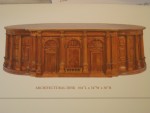
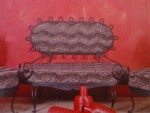
(the round table is by Buontalenti, a French/Polish company, but in the traditional Italian furniture section; the couch thing is by MetalChic)
Though contemporary furniture manufacturers come up with some pretty ridiculous designs, too:
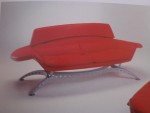
Food design
Continuing a show I saw advertised in Turin last year (maybe a dry run?) the Milan fair featured a special theme on food design, where designers and design schools were invited to redesign the whole food process, from the restaurant down to the actual delivery of the product.The Kono Pizza stand tried to reinvent the Italian classic as a combination wrap/ice-cream cone (but hot), and so had to reinvent the whole presentation of the product:

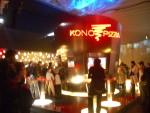
There was also a solid coffee bar (yes, the coffee was solid, though I didn't see it being delivered, so I don't know how solid), which I didn't get pictures of.
This wine store used wine bottles as walls, which I liked:
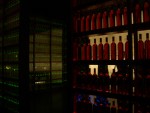
However, a croissant shop in a disco doesn't really work for me:
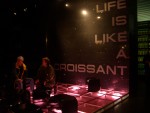
(and how is life like a croissant? Flaky and twisted?)
At the Salone Satellite, an adjunct to the main fair where independent designers exhibit, a number of design schools from various countries created restaurants. Maybe I'm projecting, but it was interesting to see how national character permeates design (maybe intentionally).
The Osaka University of the Arts' pizza restaurant looked more Japanese than Italian:
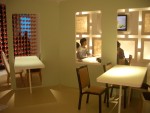
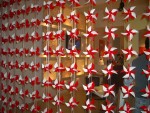
Trace, an installation from RISD, was elegant, beautiful and (they being an American school), firmly grounded in technology. Though I clearly enjoy the technology, I realize that it reflects American technolphilia. This was clearly apparent in how the presentations of Design Academy Eindhoven and Art Center students differered when they showed their work at the Metropolis conference in New York. The Dutch students spent a week collecting street trash and making stuff from it, and were quite proud of the fact that their students could sew, knit and didn't rely on computers. Art Center's students presented much slicker (though not necessarily better designed) and commercial work, but all their work was clearly only possible to manufacture with computers. I think both positions reflect a kind of willing blindness that's too limiting, but it's interesting to see how cultural it is.
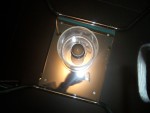
The Japanese restaurant by the University of Art and Design Helsinki seemed to be a lot more about evoking Finnish cold than evoking Japan:
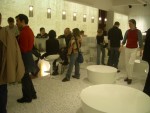
And the Jerusalem-based Bezalel Academy of Art and Design's French restaurant was called "Partingline" and featured a harsh bisection of the space, with divided plates, seats (that only worked when both parts were used) and a bisected space:
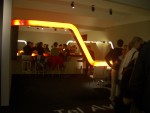
Food gadgets
Some ideas are so good, they get to be invented twice. At opposite ends of the Milan fair: cake plates with marks to indicate where to cut to get a given uneven number of slices: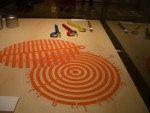
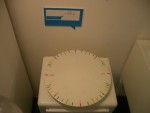
I also liked this set of as sushi utensils made to look like pieces of sliced-up mugs (from the Finnish design school restaurant):
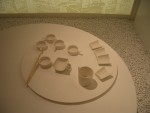
Favorite things
In terms of furniture, my favorite stuff in both shows came from the experimental, more techie side of things.
A screw Bookshelf by Rose Cobb:
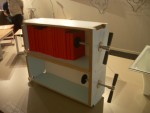
A heated concrete couch (by three Swedish designers).
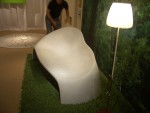
Molly fell in love with this lamp at first sight and bought it on the spot. Though I like the design, I'm really excite because of what it means for mass-market customization. It's printed using a polyester rapid prototyping printer, which means that--theoretically--each one can be different, since they're grown individually. In fact, they include a disk with the lamp design as part of the purchase package. Molly named it "lampy":
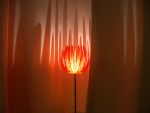
Stools made of old skis by defyra (from the excellent designersblock show, which probably had the highest density of smart, original design of anywhere in either the Mlan or New York shows):
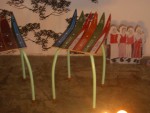
Of course one of my favorite things was experiencing all of the materials. In New York I got to see the amazing transparent concrete everyone's been talking about, and a beautiful murky green plastic with embedded grass which looks like you're swimming through the reeds in a pond, and chain mail made of ceramic rings.
The Side Show
Finally, the weird stuff. It's easy to pick on people for using improper English when trying to look cool, but there was some very amusingly nonsensical copy, which made no sense regardless of the language it was written in: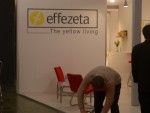
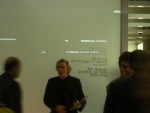
And some installations were, well, indescribable. It's not clear what the exhibit designers were thinking when they made an S&M dungeon living room:
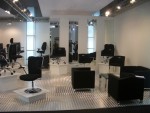
Or this 1970s concept kitchen (look, orange! and, OK, it was the 70s…):
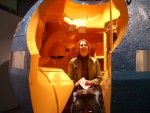
Or this pretty, if impractical, concept design from a Ukranian (I think) design school:
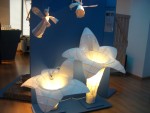
Or this one, from the same show:
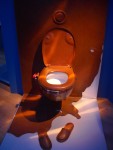
And I still don't know what this was about:
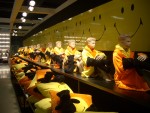
Tomorrow, or soon: the smart furniture!
(also, apologies to all of the designers whose work I'm showing without attribution, I was mostly snapping pictures and not taking too many notes, so please excuse me--if you see this all tell me where to link for any of the things I've mentioned, I'll be happy to put in a link)
Two Furniture Fairs (part 1)
Since my furniture manifesto was being published, I decided to learn something about the furniture business by diving into the deep end. In April, I went to the Milan Furniture Fair (the Salone Internazionale del Mobile) and then International Contemporary Furniture Fair in New York in May. It's hard to distill these enormous fairs into some blog entries, but here are some thoughts/observations. For those who are in the business who may be reading this, excuse me if I state the obvious or jump to conclusions.
The first thing that surprised me was how enormous and fragmented the industry is. Here's a map of the Milan center that hosts the Salone. It's probably half a square mile in area and on multiple floors:
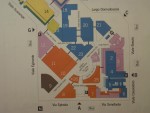
The second thing that surprised me was how much of furniture is fashion. It's obvious in retrospect, but I'm new at this and previously was only exposed to high design furniture in magazines and stores, I had expected a deep culture of innovation. The reality is expectedly more mundane. The majority of companies and designers are not trying to push any boundaries, but to create the most "now" pieces, the ones that look the most like the archetypes of what "today's" fashion is supposed to be. This leads not to innovation, but nearly stultifying repetition, and that's fine--when any consumer-products industry is seen this way, I suspect it's like this.
High design is a miniscule part of the market, as can be expected (and as Capellini, one of the touchstones of contemporary Italian avant garde design, found out a difficult place to make money).
In terms of identifying the fashions, there were several notable themes:
Corners!
This is the most high-design of the current styles. A major furniture fashion trend is the use of massively rectilinear low, flat, Japanese-influenced elements, often pairing dark woods or woods with obvious grains with chrome. Most of this stuff is in shades of brown and, frankly, I think a lot of it is quite elegant and beautiful, but it's overwhelming and so cold. Presumably the wood grains and earthtones are designed to soften, warm and humanize the cold designs, but they really don't. It all still comes off as looking like you're living in a metal shop: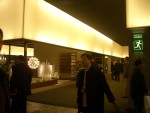
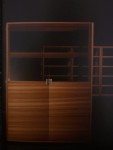
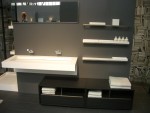
(the first image is from the Cecchini Collection.)
Molly and I saw a more mass-market version of this when we stayed in a recenty-revamped Business Class room (which, in itself, is a clever remapping of airline terminology to hotel rooms) at the SAS Radisson in Oslo. However, in practice it turned out to look more low-rent than it did in the showrooms, which is kind of a testament to how easy it is for this style to degrade to formica+chrome.
Rounded corners!
As a culture, the furniture design culture seems to be recycling Modernism. It's not just stuck in the Bauhaus agenda of expressing material properties through design, but a rampant copying of the Midcentury designers who embraced these ideas. Molly and I counted 4 design-patent skirting variations of Mies' Barcelona chair [link], and we probably passed 10 more. I'm not sure I want to dig into the explanation of this entrenched nostalgia--conservatism masked as avant garde--but it pretty much rules.(I don't have any pictures of these pieces because, well, we've seen them all before and I didn't think to take any)
No corners!
Globular biomorphism is the opposite end, and seems to be prevalent in funky office design: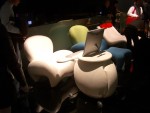
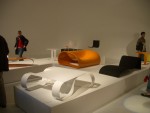
Orange!
As red is the third color (after black and white--in language, art, politics and printing), orange seems to be the fourth when it comes to furniture design. I thought that the International Council--or whatever that organization is called--said that Orange=1998, but clearly not here. It's in full flower.Form follows fashion
One obvious trend in furniture design that defines it as primarily fashion-driven, rather than function-driven is the amount of terrible, uncomfortable furniture that looks good.Here's Molly trying out a plastic foldable bench/couch:
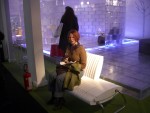
Here's a wall-mounted plastic tet-a-tet couch thing that is an interesting use of injection-molded plastic, but looks nothing so much as an enormous urinal, and is about as comfortable to sit in:
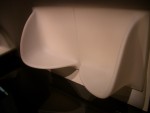
(and props to Henry Petroski and his excellent book The Evolution of Useful Things for the "form follows fashion" phrase)
"Do not sit on couch"
One very pleasant surprise about the design show is that everyone touches everything. So much of the design is tactile that people touch, poke and caress everything and--unlike museums and snooty design stores—it's encouraged. So I had a great time touching stuff and feeling materials directly, which was great.April 19, 2004
2004 Milan Furniture Fair Impressions
I will write more about this later, because Molly and I are taking a couple of days off after the craziness of the 2004 Milan Furniture Fair (the Salone dei Mobile in Italian). I'll write some more afterward, but here are some random images from I took.
Some first impressions:
- Orange is still the new red (red is also still the new red)
- Woodgrain is still the new Formica
- Comfort is still nonexistent
- As far as most "mainstream avant garde" design is concerned, it's still 1970
- The Barcelona Chair is the most frequently copied classic chair
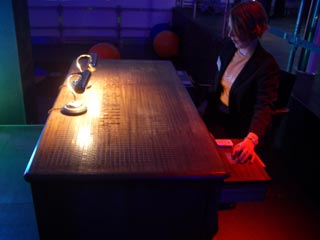 |
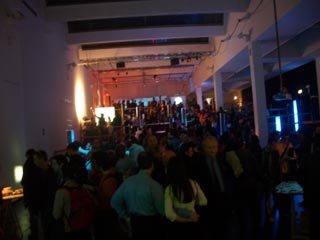 |
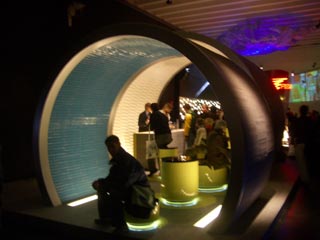 |
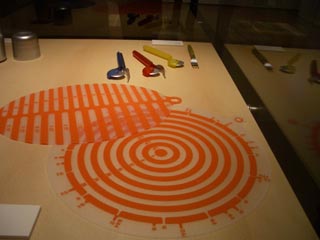 |
 |
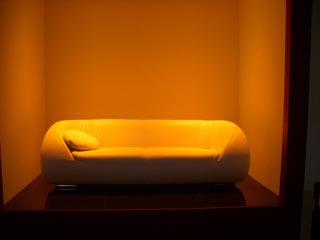 |
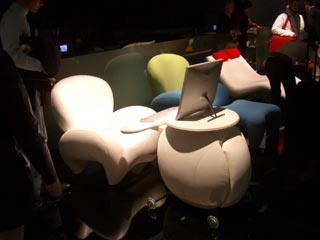 |
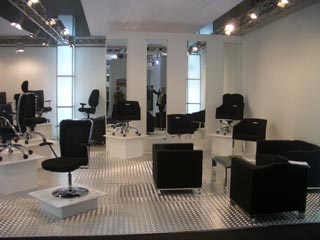 |
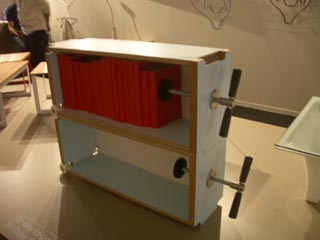 |
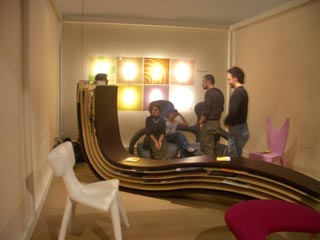 |
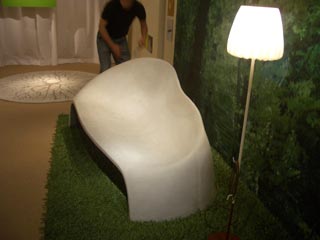 |
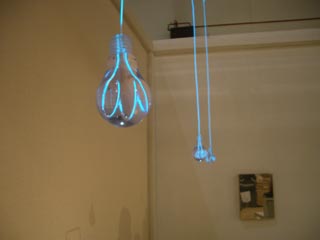 |
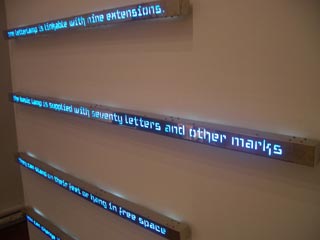 |
 |
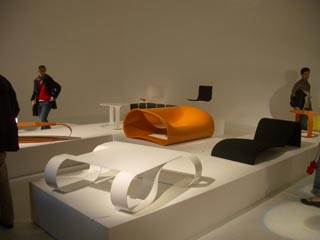 |
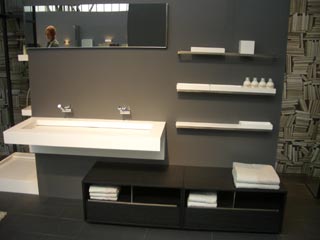 |
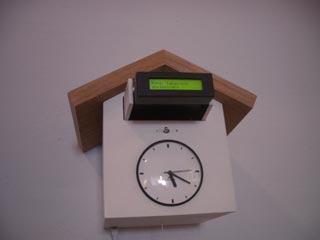 |
 |
March 28, 2004
Lantronix WiPort/Xport
Lantronix has released two interesting products for the embedded hardware market, the WiPort and the Xport. These are tiny Ethernet transceivers (one wireless, the other not) that add connectivity to devices without requiring a whole lot of knowledge about how the connectivity works. Each one has a complete "TCP/IP network stack and OS" and, most usefully, "an embedded web server that can be used to remotely configure, monitor, or troubleshoot the attached device." In the case of the Xport, all of this is in a package barely bigger than the 10BaseT connector that fits into it (not that 10BaseT is going to be meaningful for consumer products for much longer, but it's a cool hack).
It's clear to me that as the market for embedded intelligence matures, plug and play modules like these are going to become more popular, which will further increase the speed at which embedded communicate and intelligence appears in consumer products. I can envision a point, oh say five years from now, when not having some kind of embedded communication in devices will be bad design. There's probably going to be all kinds of interference and interoperability issues at that point, but everything will likely be able to talk on the Net. I'm excited!
January 28, 2004
WiFI Ethernet + GPS database = GPS--
I was looking at the NetStumber national access point map and noticing that it hasn't been updated in a while. Clearly the excitement of finding WiFi access points has worn off. But it started me thinking. What if there was a way to use that kind of data--the incomplete, potentially erroneous, volunteed-created--data, because there seems to be something interesting about knowing the GPS location of a given access point? I mean, access points don't tend to move and are broadcasting their IDs (in the form of their Ethernet addresses) all the time, regardless of whether you can log on to use the Net. How could that be useful?
It's useful in this way: until GPS hardware gets to be cheap enough to incorporate into everything as WiFi and Bluetooth are now, using Access Point/GPS location databases can create a cheap kind of GPS for WiFi devices. All that has to be done is that a table matching one with the other has to be downloaded to a device, and then when that device sees the Ethernet address appear, it knows (with some rough degree of certainty) where it is. Imagine a busy downtown area, such as the Financial District in San Francisco. There are dozens of visible WiFi access points per block. Sure you can only log into maybe 10% of them, but who cares if all you're looking for is their Ethernet address? Downtown SF is full of history: this giant area here was once the bay, here was where the Niantic Hotel used to stand, here's where that fire raged in 1906, etc. I can imagine creating a tour of downtown San Francisco that would fit on a WiFi-enabled PDA--something that's likely a whole lot more common than a GPS-enabled PDA--and would allow you to walk around downtown, giving you information for which the location was determined by the WiFi access points visible to the PDA.
Would it be super accurate? Of course not. But it would be cheap from a hardware standpoint--it would be expensive from a data-collection standpoint, but not ALL that expensive. One afternoon walking with NetStumbler would collect all of the necessary data, and it could be updated every six months, with the tour cues synched appropriately.
Sure it's a silly stopgap measure until actual geolocation becomes available, but I think that there's a whole lot more opportunity here than just downtown tours.
December 11, 2003
My First Disney
One of my favorite attempts at brand extension (although not altogether a successful one, I suspect) was the My First Sony line of kids technology. Those products were probably the biggest impact that the Memphis Group style of the 80s had on pop culture (apart from the set design in Ruthless People, that is). Now the idea is back, in the form of Disney's new electronics for kids. I can already see a set of these in every designer's house. Hell, if the TV was a little bigger and an LCD, I'd buy one right now.
Oh and thanks to Gizmodo for the link My new favorite consumer product geek site.
December 05, 2003
GPS Video Game
An announcement of someone developing a GPS-enabled handheld game system. This is yet more of the conversion of "all electronic objects about the size of your hand" that I'm expecting will be in high gear soon--pretty much until phones, cameras, gps devices, remotes and anything else that looks like that become a single object. The question will then be what to call that object.
But back to the game. First of all, it really underscores the fact that kids don't have nearly the same rights that adults do. An object that let someone else track your whereabouts remotely would certainly be much more difficult to propose and accept if targeted toward adults. And the possible misuses of that information are really extreme. If I was a kid in a group of kids with these things, the first thing I'd do is swap 'em with my friends so that our parents wouldn't know whose kid they were tracking, and then swap those with friends from neighboring towns, etc. Second of all, it seems like they're missing the most interesting part of this: that geolocation can be a critical part of the game, not just as a surveillance device. Sheesh, if you're going to be building the hardware and communication infrastructure into this thing to do all of the tracking, why not make it an actual feature for the user of the system?
November 24, 2003
Smart Dust=Smart Home Nets
Scott sent me a link to a story on the public trials of the DARPA "Smart Dust" project that's been floating around for the last four years.
This is the key idea: "By self-organizing into a sensor network, smart dust would filter raw data for relevance before relaying only the important findings to central command."
In other words, it's a bunch of generic sensor modules that link to form--ant-colony-like--a single sensory entity that uses heurists about data goodness to extract knowledge from a lot of randomly collected data. I see several interesting things here:
- Self-organization (Using TinyOS)
- Small sensors (what's important to sense? how do you sense it?)
- Relevance filtering (how do you pull knowledge out? How do you know what's important?)
The dystopian possibilities are obvious and ominous, but I think that interesting output is possible for home networks without it becoming Demon Seed.
October 27, 2003
HTML as GUI commodity
Slashdot posted a story about an embedded HTML renderer being used for creating GUIs for medical devices. The story they point to is written by the marketing director of a company that's trying to sell the technology and, frankly, not all that interesting from a technology standpoint. It made me think, however, that basic Web technology has gotten stable enough and knowledge about it has gotten distributed enough, that including an HTML renderer for GUIs is almost a commodity idea, that it's a no-brainer to make UIs HTML-based, rather than creating a proprietary system. Even just a couple of years ago, the phone industry was trying to introduce WAP, which was a "simplified" version of HTML. Now, there's no need to simplify. From a device creator's perspective, an HTML renderer is nearly as much of a commodity as a clock chip or a serial port.
The effect that this has on device design may not be profound from an innovation standpoint, but from a development standpoint, it could be very big. Once HTML-based GUI rendering becomes as easy as putting a block on a block diagram, it's much easier to include it in engineered objects. It becomes a part of the production process, rather than part of R&D. I can imagine many more things growing rendered UIs because it's cheaper than creating them "in hardware." It's like when plastic backlit signs almost completely replaced neon signs. It not because the technology was any better or prettier, but because they were much cheaper to install, change and maintain.
October 17, 2003
Gameboy meets Palm Pilot, finally
The Tapwave Zodiac looks to be a nifty PDA-like device at just about the right price point to capture the market of 20-somethings who grew up with Gameboys, but have dayjobs. It makes more sense to me than the PDA-phone bricks that were around last year and, if it had a Danger-like mobile Net connection (not to be used as a phone, of course, but just to use the digital phone network) and a thumb keyboard, it would be a truly great device, an adult Cybiko. I'm sure they're working on it, but I hope they converge that functionality to it quickly.
September 09, 2003
Ricoh's new GPS camera
I've been waiting for consumer-grade easy-to-use GPS-enabled digital cameras to come out since handheld GPS units and digital cameras came out. It seemed like a natural match for documentation purposes, especially if there was a standard for tagging the data. Ricoh came out with the RDC-1700G, an expensive Japanese-only GPS camera last year, but now they've released the Caplio Pro G3, a much cheaper consumer model. It's still only for the Japanese market, but the fact that they made it based on a consumer platform is a good sign that it may be available elsewhere soon. I think that this will be a huge boon to the visual blogging world. I can see services that bring together photoblogging and Indy Junior to make something like GeoSnapper much more acessible. I'm looking foreward to using one, but I can also see the downside: it won't take long for someone to forget to remove the GPS metadata from some picture that really shouldn't have it and then get into trouble.
The next question: when is the GPS-camera-phone going to come out? It only makes sense (as it has for, gee, 5 years?) for these three handheld, plastic, personal information tools to be coupled. Merge the Caplio with the Danger Hiptop with some backend photo management software and you have a pretty serious tool for documenting the world in real time.
September 04, 2003
Making Things
I've seen a number of these toolkits (from Lego Mindstorms onward), which promise simple modules that artists (i.e. non-electrical engineers) can use to create real-world electronic projects. I'm surprised that this particular wheel gets reinvented, but it just shows that no really good system exists yet. That said, Making Things looks pretty good and got a good review from Sasha on the puppets list. It also connects with Max/MSP, which I consider one of the most deceptively powerful programming systems around (deceptive because visual programming is only easier than regular programming for very small things--it becomes serious spaghetti quickly; powerful because it looks like more of a toy than it is).
Interesting.
August 19, 2003
Cheap, low-power wireless and IP
So Cypress has a new Wireless USB technology. I'm not sure how this relates to the whole batch of current wireless standards operating in 2.4 GHz (which includes Bluetooth, the WiFi family and various other consumer electronics devices), but it's yet another choice in the "getting devices to talk" game.
Likewise, I think that it's really cool that Maxim/Dallas Semiconductor have created an embedded processor with a TCP/IP stack built into it. Granted, Java chips have probably had this kind of thing for a while, but having a single, small chip with an IP stack (called TINI ) is pretty nifty.
I can imagine how the combination of these types of technologies--cheap low-power IP-enabled chips plus cheap low-power wireless communication (the key words being cheap and low-power in both cases, since this stuff exists in all kinds of more expensive/higher-power formats already) could enable some interesting new applications.
